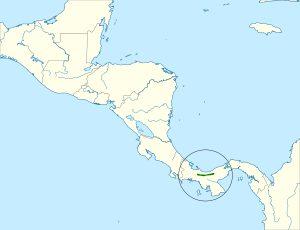Yellow-green brushfinch facts for kids
Quick facts for kids Yellow-green brushfinch |
|
|---|---|
| Conservation status | |
| Scientific classification | |
| Genus: |
Atlapetes
|
| Species: |
luteoviridis
|
 |
|
The yellow-green brushfinch (Atlapetes luteoviridis) is a small, colorful bird that lives in the forests of Panama. It belongs to the Passerellidae family, which includes sparrows and buntings. This bird is special because it is found only in Panama, making it an endemic species.
Sadly, the yellow-green brushfinch is facing a big problem: its home is disappearing. This is called habitat loss, and it threatens the future of these unique birds.
Contents
About the Yellow-Green Brushfinch
The yellow-green brushfinch gets its name from its bright feathers. It has a mix of yellow and green colors, helping it blend into the leafy forest environment. These birds are usually shy and can be hard to spot among the trees.
Where It Lives
This brushfinch lives only in the country of Panama, a narrow land bridge connecting North and South America. It prefers specific types of forests found high up in the mountains.
Its Mountain Home
The natural habitat of the yellow-green brushfinch is called a subtropical or tropical moist montane forest. Imagine a forest that is always warm and wet, located on the slopes of mountains. These forests are full of tall trees, thick plants, and often have clouds or mist hanging around them. This misty environment provides the perfect conditions for many unique plants and animals, including our brushfinch.
Why It's Special
When an animal or plant is "endemic" to a place, it means it lives naturally only in that specific area and nowhere else in the world. The yellow-green brushfinch is endemic to Panama. This makes it very important to protect, because if its habitat in Panama is destroyed, the species could disappear entirely.
Facing Challenges
The biggest threat to the yellow-green brushfinch is habitat loss. This happens when the forests where it lives are cut down or changed by human activities.
What is Habitat Loss?
Habitat loss can happen for many reasons. People might clear forests to build farms, towns, or roads. Logging, which is cutting down trees for wood, also destroys these important habitats. When the forest is gone, the birds lose their homes, their food sources, and places to raise their young. This makes it very hard for them to survive and thrive.
Protecting Their Future
Conservation efforts are important to protect the yellow-green brushfinch. This means working to save their forest homes and ensure these beautiful birds can continue to live freely in Panama's mountains. Protecting their habitat helps not only the brushfinch but also many other plants and animals that share the same special environment.
Images for kids
See also
 In Spanish: Cerquero verdiamarillo para niños
In Spanish: Cerquero verdiamarillo para niños



